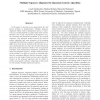10 search results - page 2 / 2 » Structure and function predictions of the Msa protein in Sta... |
BMCBI
2006
13 years 4 months ago
2006
Background: Recently there has been a lot of interest in identifying modules at the level of genetic and metabolic networks of organisms, as well as in identifying single genes an...
BMCBI
2008
13 years 4 months ago
2008
Background: A multiple sequence alignment (MSA) generated for a protein can be used to characterise residues by means of a statistical analysis of single columns. In addition to t...
IPPS
2006
IEEE
13 years 10 months ago
2006
IEEE
In this paper we describe a new approach for the well known problem in bioinformatics: Multiple Sequence Alignment (MSA). MSA is fundamental task as it represents an essential pla...
BMCBI
2006
13 years 4 months ago
2006
Background: Members of a protein family often have highly conserved sequences; most of these sequences carry identical biological functions and possess similar three-dimensional (...
BMCBI
2004
13 years 4 months ago
2004
Background: In a previous paper, we introduced MUSCLE, a new program for creating multiple alignments of protein sequences, giving a brief summary of the algorithm and showing MUS...


